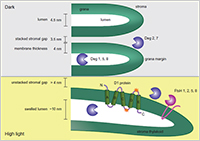Enlarge Image
Molecular and structural light adjustments protect plants
Miho Yoshioka-Nishimura at Okayama University summarises the latest progress in understanding at the molecular level how plants respond to changes in light conditions.
“Light is necessary for photochemical reactions of photosynthesis; however, light is one of the most fluctuating environmental factors in nature,” explains Yoshioka-Nishimura in her mini review. She describes how plants adapt to harvest light more efficiently in shady conditions, as well as the two main strategies adopted – molecular and structural – that protect plants from harsh high light intensities.
A major cause of damage under over-exposure to light is the production of reactive oxygen species (ROS) in the chloroplasts due to the over-reduction of photosystem II (PSII) the main protein complex involved in light-dependent oxygenic photosynthesis reactions. Specific enzymes, antioxidants and pigments present in the chloroplasts can contribute to absorbing some of these ROS before they damage key photosynthesis protein complexes.
However the structure of the cell components within the chloroplasts itself is key to its ability to harvest light efficiently and conversely its susceptibility to light damage. Light-dependent photosynthesis reactions occur within compartments bound by thylakoid membranes, which have subdomains of flat grana thylakoids and linking stromal thylakoids. In plants that thrive in shaded areas, the thylakoid grana are stacked, which facilitates energy transfer processes. In high light conditions these grana can become unstacked and bent, which diminishes energy and electron carrier transfer processes. The aqueous phase bound by the thylakoid (the lumen) also swells in response to light and this can improve the mobility of enzymes that degrade and replace damaged proteins.
High light conditions can also lead to protein complex aggregation, diminishing their mobility. In low light conditions this is reversed but if the over-exposure of light is too great and the aggregates accumulate, and aggregation becomes irreversible. As Yoshioka-Nishimura points out in the article, “Membrane fluidity and mobility of proteins are crucial points for understanding the effects of light stress on PSII at the molecular level.”
Publication and Affiliation
Miho Yoshioka-Nishimura* Close relationships between the PSII repair cycle and thylakoid membrane dynamics. 2016 Plant and Cell Physiology 1115-1122
Graduate School of Natural Science and Technology, Okayama University, Okayama, 700-8530 Japan
*corresponding author, e-mail address: yoshi-m3@cc.okayama-u.ac.jp

